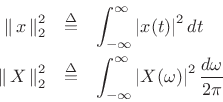The Uncertainty Principle
The uncertainty principle (for Fourier transform pairs) follows immediately from the scaling theorem (§B.4). It may be loosely stated as
Time DurationwhereFrequency Bandwidth
c
If duration and bandwidth are defined as the ``nonzero interval,''
then we obtain ![]() , which is not useful. This conclusion
follows immediately from the definition of the Fourier transform
and its inverse (§2.2).
, which is not useful. This conclusion
follows immediately from the definition of the Fourier transform
and its inverse (§2.2).
Duration and Bandwidth as Second Moments
More interesting definitions of duration and bandwidth are obtained
using the normalized second moments of the squared magnitude:
where

By the DTFT power theorem (§2.3.8), we have
![]() . Note that writing ``
. Note that writing ``
![]() '' and
``
'' and
``
![]() '' is an abuse of notation, but a convenient one.
These duration/bandwidth definitions are routinely used in physics,
e.g., in connection with the Heisenberg uncertainty principle [59].Under these definitions, we have the following theorem
[202, p. 273-274]:
'' is an abuse of notation, but a convenient one.
These duration/bandwidth definitions are routinely used in physics,
e.g., in connection with the Heisenberg uncertainty principle [59].Under these definitions, we have the following theorem
[202, p. 273-274]:
Theorem: If
![]() as
as
![]() , then
, then
with equality if and only if
| (B.63) |
That is, only the Gaussian function (also known as the ``bell curve'' or ``normal curve'') achieves the lower bound on the time-bandwidth product.
Proof: Without loss of generality, we may take consider ![]() to be real
and normalized to have unit
to be real
and normalized to have unit ![]() norm (
norm (
![]() ). From the
Schwarz inequality [264],B.2
). From the
Schwarz inequality [264],B.2
The left-hand side can be evaluated using integration by parts:
 |
(B.65) |
where we used the assumption that
The second term on the right-hand side of (B.65) can be evaluated using the power theorem and differentiation theorem (§B.2):
 |
(B.66) |
Substituting these evaluations into (B.65) gives
 |
(B.67) |
Taking the square root of both sides gives the uncertainty relation sought.
If equality holds in the uncertainty relation (B.63), then (B.65) implies
 |
(B.68) |
for some constant
Time-Limited Signals
If ![]() for
for
![]() , then
, then
| (B.69) |
where
Proof: See [202, pp. 274-5].
Time-Bandwidth Products Unbounded Above
We have considered two lower bounds for the time-bandwidth product
based on two different definitions of duration in time. In the
opposite direction, there is no upper bound on time-bandwidth
product. To see this, imagine filtering an arbitrary signal with an
allpass filter.B.3 The allpass filter cannot affect
bandwidth
![]() , but the duration
, but the duration ![]() can be arbitrarily extended by
successive applications of the allpass filter.
can be arbitrarily extended by
successive applications of the allpass filter.
Next Section:
Relation of Smoothness to Roll-Off Rate
Previous Section:
Sampling Theory











![$\displaystyle \left\vert\int_{-\infty}^\infty t x(t) \left[\frac{d}{dt}x(t)\right] dt\right\vert^2 \leq \int_{-\infty}^\infty t^2 x^2(t) dt \int_{-\infty}^\infty \left\vert\frac{d}{dt}x(t)\right\vert^2 dt. \protect$](http://www.dsprelated.com/josimages_new/sasp2/img2561.png)












